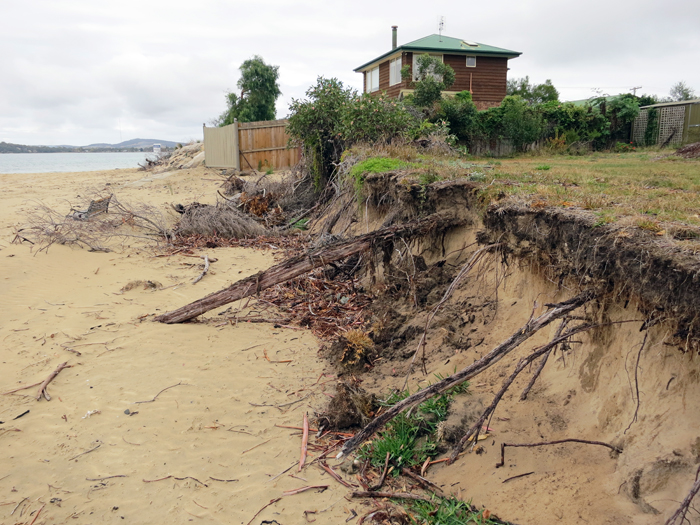Whatever else can be said about the Liberal-National government’s climate policies, they got this one right

Coastal erosion at Roches Beach, southern Tasmania, April 2012. PHOTO P. Boyer
Amid all the uncertainty about our climate future, here’s an absolute certainty: in coming decades our coasts will come under increasing attack from the sea.
By 2050, increased melting of ice sheets in Antarctica and Greenland – already locked into the global climate system – will have caused a perceptible rise in sea levels, possibly over 30 cm.
Science also tells us that every 10 cm of sea level rise makes coastal flooding from storms and high tides about three times more likely. By that reckoning, by 2050 our coasts will be flooding 27 times more often than now, and at record-high levels.
The world’s biggest island-nation has to look for ways to adapt to this reality. That was the challenge presented to the National Climate Change Adaptation Research Facility (NCCARF) by the incoming Abbott government in 2013.
Set up by the Howard government in 2007 and based at Griffith University on Queensland’s Gold Coast, NCCARF has had a chequered history. Labor governments focused on mitigating carbon emissions rather than adapting to change, and in 2013 the facility seemed headed for oblivion.
But adaptation went to the top of the climate agenda when Greg Hunt took over the environment portfolio. With his encouragement, NCCARF set about creating a one-stop coastal information resource for use by anyone in Australia with a stake in our coastal lands.
Workshops around Australia in 2014-15 brought together representatives of local government, water, transport and other coastal authorities, small businesses and community-based groups. These, plus an online survey, helped established what we know and don’t know about our coasts.
The website combines old and new knowledge into an amazingly comprehensive coastal planning package. The beta version is available now and is scheduled to be launched in April next year.
CoastAdapt explores in detail the many dynamics that shape our coasts, taking in river flow, wind, waves and sea currents, sediment deposition, ocean chemistry and weather patterns. It offers guidance on assessing risk, including templates and modelling tools.
High-definition mapping tools explore sea level rise under different emission scenarios and vulnerability to erosion around the entire Australian coastline, using data sets compiled over many years.
It discusses the processes needed to adapt successfully to inevitable change, including working with consultants, legal risk and jurisdictional differences, and how to build in capacity to deal with new, unforeseen circumstances as they arise.
CoastAdapt incorporates two online forums, allowing users to share ideas and approaches with others in a similar situation and to get professional advice on adaptation issues.
Perhaps its most valuable tool is a collection of 54 case studies looking at the actual experience of a wide array of local governments, other coastal authorities, research projects, farms, other businesses and community groups.
Tasmanian case studies include a video about the work done by Kingborough Council, led by environment officer Jon Doole, to prepare Kingston Beach for a future subjected to both marine and river flooding exacerbated by rising sea level and more intense wind-rain events.
Eric Woehler of Birdlife Tasmania looked at the impact of sea level rise on the natural values of Tasmanian coasts, identifying Australia-wide priorities for landscape-scale coastal conservation.
Some of the information in CoastAdapt may come across as academic, but its basic value is good solid guidance on real-world issues, including potential legal and administrative pitfalls in dealing with a changing coastal landscape.
With the world feeling its way towards an uncertain future, it’s a relief to come across coherent, well-considered, practical information that we can apply to our own local circumstances. This is a real treasure-chest, and a credit to both NCCARF and Hunt (now science minister).
Unfortunately its charter does not extend to the biggest question of all: balancing the cost of mitigating change now against the cost of dealing with consequences later. We have yet to apply ourselves to that critical equation, but it’s way past time we did.
